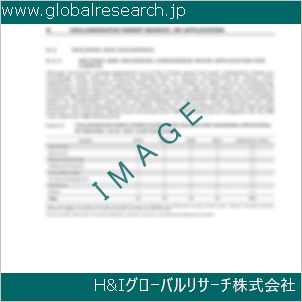Table of Contents
1 Industry Overview of Styrene
1.1 Definition and Specifications of Styrene
1.1.1 Definition of Styrene
1.1.2 Specifications of Styrene
1.2 Classification of Styrene
1.3 Applications of Styrene
1.3.1 Nuclear Application
1.3.2 Non-Nuclear Application
1.4 Industry Chain Structure of Styrene
1.5 Industry Overview and Major Regions Status of Styrene
1.5.1 Industry Overview of Styrene
1.5.2 Global Major Regions Status of Styrene
1.6 Industry Policy Analysis of Styrene
1.7 Industry News Analysis of Styrene
2 Manufacturing Cost Structure Analysis of Styrene
2.1 Raw Material Suppliers and Price Analysis of Styrene
2.2 Equipment Suppliers and Price Analysis of Styrene
2.3 Labor Cost Analysis of Styrene
2.4 Other Costs Analysis of Styrene
2.5 Manufacturing Cost Structure Analysis of Styrene
2.6 Manufacturing Process Analysis of Styrene
3 Technical Data and Manufacturing Plants Analysis of Styrene
3.1 Capacity and Commercial Production Date of Global Styrene Major Manufacturers in 2023
3.2 Manufacturing Plants Distribution of Global Styrene Major Manufacturers in 2023
3.3 R&D Status and Technology Source of Global Styrene Major Manufacturers in 2023
3.4 Raw Materials Sources Analysis of Global Styrene Major Manufacturers in 2023
4 Capacity, Production and Revenue Analysis of Styrene by Regions, Types and Manufacturers
4.1 Global Capacity, Production and Revenue of Styrene by Regions 2019-2024
4.2 Global and Major Regions Capacity, Production, Revenue and Growth Rate of Styrene 2019-2024
4.3 Global Capacity, Production and Revenue of Styrene by Types 2019-2024
4.4 Global Capacity, Production and Revenue of Styrene by Manufacturers 2019-2024
5 Price, Cost, Gross and Gross Margin Analysis of Styrene by Regions, Types and Manufacturers
5.1 Price, Cost, Gross and Gross Margin Analysis of Styrene by Regions 2019-2024
5.2 Price, Cost, Gross and Gross Margin Analysis of Styrene by Types 2019-2024
5.3 Price, Cost, Gross and Gross Margin Analysis of Styrene by Manufacturers 2019-2024
6 Consumption Volume, Consumption Value and Sale Price Analysis of Styrene by Regions, Types and Applications
6.1 Global Consumption Volume and Consumption Value of Styrene by Regions 2019-2024
6.2 Global and Major Regions Consumption Volume, Consumption Value and Growth Rate of Styrene 2019-2024
6.3 Global Consumption Volume and Consumption Value of Styrene by Types 2019-2024
6.4 Global Consumption Volume and Consumption Value of Styrene by Applications 2019-2024
6.5 Sale Price of Styrene by Regions 2019-2024
6.6 Sale Price of Styrene by Types 2019-2024
6.7 Sale Price of Styrene by Applications 2019-2024
6.8 Market Share Analysis of Styrene by Different Sale Price Levels
7 Supply, Import, Export and Consumption Analysis of Styrene
7.1 Supply, Consumption and Gap of Styrene 2019-2024
7.2 Global Capacity, Production, Price, Cost, Revenue, Supply, Import, Export and Consumption of Styrene 2019-2024
7.3 USA Capacity, Production, Price, Cost, Revenue, Supply, Import, Export and Consumption of Styrene 2019-2024
7.4 EU Capacity, Production, Price, Cost, Revenue, Supply, Import, Export and Consumption of Styrene 2019-2024
7.5 China Capacity, Production, Price, Cost, Revenue, Supply, Import, Export and Consumption of Styrene 2019-2024
7.6 Japan Capacity, Production, Price, Cost, Revenue, Supply, Import, Export and Consumption of Styrene 2019-2024
8 Major Manufacturers Analysis of Styrene
8.1 Manufacturer One
8.1.1 Company Profile
8.1.2 Product Picture and Specifications
8.1.2.1 Type I
8.1.2.2 Type II
8.1.2.3 Type III
8.1.3 Capacity, Production, Price, Cost, Gross and Revenue
8.1.4 Contact Information
8.2 Manufacturer Two
8.2.1 Company Profile
8.2.2 Product Picture and Specifications
8.2.2.1 Type I
8.2.2.2 Type II
8.2.2.3 Type III
8.2.3 Capacity, Production, Price, Cost, Gross and Revenue
8.2.4 Contact Information
8.3 Manufacturer Three
8.3.1 Company Profile
8.3.2 Product Picture and Specifications
8.3.2.1 Type I
8.3.2.2 Type II
8.3.2.3 Type III
8.3.3 Capacity, Production, Price, Cost, Gross and Revenue
8.3.4 Contact Information
8.4 Manufacturer Four
8.4.1 Company Profile
8.4.2 Product Picture and Specifications
8.4.2.1 Type I
8.4.2.2 Type II
8.4.2.3 Type III
8.4.3 Capacity, Production, Price, Cost, Gross and Revenue
8.4.4 Contact Information
8.5 Manufacturer Five
8.5.1 Company Profile
8.5.2 Product Picture and Specifications
8.5.2.1 Type I
8.5.2.2 Type II
8.5.2.3 Type III
8.5.3 Capacity, Production, Price, Cost, Gross and Revenue
8.5.4 Contact Information
…
9 Marketing Trader or Distributor Analysis of Styrene
9.1 Marketing Channels Status of Styrene
9.2 Traders or Distributors with Contact Information of Styrene by Regions
9.3 Ex-work Price, Channel Price and End Buyer Price Analysis of Styrene
9.4 Regional Import, Export and Trade Analysis of Styrene
10 Industry Chain Analysis of Styrene
10.1 Upstream Major Raw Materials Suppliers Analysis of Styrene
10.1.1 Major Raw Materials Suppliers with Contact Information Analysis of Styrene
10.1.2 Major Raw Materials Suppliers with Supply Volume Analysis of Styrene by Regions
10.2 Upstream Major Equipment Suppliers Analysis of Styrene
10.2.1 Major Equipment Suppliers with Contact Information Analysis of Styrene
10.2.2 Major Equipment Suppliers with Product Pictures Analysis of Styrene by Regions
10.3 Downstream Major Consumers Analysis of Styrene
10.3.1 Major Consumers with Contact Information Analysis of Styrene
10.3.2 Major Consumers with Consumption Volume Analysis of Styrene by Regions
10.4 Supply Chain Relationship Analysis of Styrene
11 Development Trend of Analysis of Styrene
11.1 Capacity, Production and Revenue Forecast of Styrene by Regions and Types
11.1.1 Global Capacity, Production and Revenue of Styrene by Regions 2024-2029
11.1.2 Global and Major Regions Capacity, Production, Revenue and Growth Rate of Styrene 2024-2029
11.1.3 Global Capacity, Production and Revenue of Styrene by Types 2024-2029
11.2 Consumption Volume and Consumption Value Forecast of Styrene by Regions, Types and Applications
11.2.1 Global Consumption Volume and Consumption Value of Styrene by Regions 2024-2029
11.2.2 Global and Major Regions Consumption Volume, Consumption Value and Growth Rate of Styrene 2024-2029
11.2.3 Global Consumption Volume and Consumption Value of Styrene by Types 2024-2029
11.2.4 Global Consumption Volume and Consumption Value of Styrene by Applications 2024-2029
11.3 Supply, Import, Export and Consumption Forecast of Styrene
11.3.1 Supply, Consumption and Gap of Styrene 2024-2029
11.3.2 Global Capacity, Production, Price, Cost, Revenue, Supply, Import, Export and Consumption of Styrene 2024-2029
11.3.3 USA Capacity, Production, Price, Cost, Revenue, Supply, Import, Export and Consumption of Styrene 2024-2029
11.3.4 EU Capacity, Production, Price, Cost, Revenue, Supply, Import, Export and Consumption of Styrene 2024-2029
11.3.5 China Capacity, Production, Price, Cost, Revenue, Supply, Import, Export and Consumption of Styrene 2024-2029
11.3.6 Japan Capacity, Production, Price, Cost, Revenue, Supply, Import, Export and Consumption of Styrene 2024-2029
12 New Project Investment Feasibility Analysis of Styrene
12.1 New Project SWOT Analysis of Styrene
12.2 New Project Investment Feasibility Analysis of Styrene
13 Conclusion of the Global Styrene (CAS 100-42-5) Industry 2024 Market Research Report
| ※参考情報 スチレン(Styrene)は、化学式C8H8を持つ有機化合物で、CAS番号100-42-5によって特定されます。この分子は、ベンゼン環にエチレン基が結合した構造を持ち、芳香族炭化水素の一種です。スチレンは無色の液体で独特の芳香があり、室温で揮発性があります。 スチレンの特徴としては、まず化学的性質があります。スチレンは、非常に反応性の高いモノマーであり、主に重合反応を経てポリスチレンやその他のスチレン系ポリマーが生成されます。この重合反応は、熱や光により促進され、さまざまな重合方法(例えばラジカル重合、陽イオン重合など)を使用することができます。また、スチレンはアクリル系化合物やブタジエンと共重合することで、エチレン-プロピレン-ジエン(EPDM)やスチレン-ブタジエンゴム(SBR)などの複合材料を作ることも可能です。 スチレンにはいくつかの種類があり、その用途に応じた異なる形態で存在しています。例えば、結晶スチレンと呼ばれる固体の形や、液体のスチレンがあります。また、工業用途においては、スチレンは主にモノマーとして使用され、ポリスチレンが最も一般的な製品です。ポリスチレンは、透明性が高く、成形性にも優れているため、食品容器や家庭用品、玩具、電気機器の部品など広範に利用されています。 スチレンの用途は非常に多岐にわたります。一般的な用途としては、発泡スチロール(EPS)や高剛性スチレン系樹脂などがあり、これらは梱包材や断熱材、建材として広く使われています。また、スチレンは塗料や接着剤、コーティング剤やシーリング剤の製造にも利用されています。スチレンベースの化合物は、強力な接着力を持ち、耐候性や耐薬品性に優れているため、様々な産業で重宝されています。 最近では、環境への配慮から、スチレンのリサイクルやバイオベースの代替品に関する研究開発も進められています。スチレン系材料は、リサイクルが難しいとされていましたが、メカニカルリサイクルやケミカルリサイクルの技術が進展することで、再利用の可能性が高まっています。また、バイオマス由来のスチレンの製造方法も探求されており、持続可能な材料開発が求められています。 関連技術としては、スチレンの合成方法が挙げられます。スチレンは伝統的には、ナフサからのクラッキングによって生産されます。このプロセスでは、ナフサを加熱して軽質炭化水素に分解し、さらに分離・精製を経てスチレンを得るのです。近年では、エタノールやバイオマスを利用したスチレンの製造プロセスの開発も進められています。 さらに、スチレンリッチのポリマー複合体の研究が進む中で、ポリマーの機能性を高めるための添加剤や化学的改良も行われています。これにより、耐熱性、耐衝撃性、UV耐性などの特性を改善し、特定の用途に特化した製品が開発されています。 スチレンは、その独特の化学的性質と多様な用途により、現代の化学工業において不可欠な材料とされています。その一方で、環境問題や健康への影響に対処するために、持続可能な技術や製品の開発が求められています。今後もスチレンやその誘導体の研究は続き、新たな可能性が模索されるでしょう。 |
❖ 免責事項 ❖
http://www.globalresearch.jp/disclaimer












